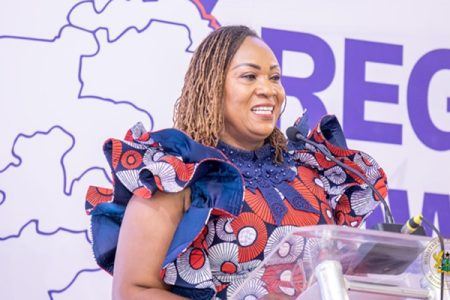The Ministry of Fisheries and Aquaculture has distributed 22,510 inputs to fishermen since assuming office.
The inputs include 6,652 outboard motors, 6,148 fishing nets, 6,000 wire mesh, and 3,710 freezers.
These beneficiaries are fishers and fish processors in coastal communities and those around the Volta Lake.
In addition to the inputs, the government has provided relief items to marine artisanal and inshore fishers.
These relief items include 35,000 bags (25kg) of rice, 14,584 boxes of 1-litre cooking oil, 7,292 boxes of tinned tomatoes, 7,292 boxes of mackerel, 4,000 bundles of wire mesh, and 15,000 pieces of aluminum basins.
Minister for Fisheries and Aquaculture, Madam Hawa Koomson, made these announcements during a Townhall Meeting in the Central Region.
She highlighted that 100 out of 300 dispensers under the Automated Premix Fuel Project are now operational, ensuring efficient tracking of distribution, transparent transactions, and accurate data collection.
The Ministry has also introduced fish farming training programs at Awutu Camp Prisons and James Camp Prisons.
Ninety participants, including 60 inmates and 30 prison officers, have been trained.
Additionally, 25 youth groups were supported with 100 ponds and 60 tarpaulin tanks, while 20 schools and institutions were equipped with 24 ponds and 60 tarpaulin tanks.
Beneficiaries received 180,000 fingerlings and 25,000 bags of fish feed.
In aquaculture development, Madam Koomson revealed that 9,500 beneficiaries across seven regions have been trained.
They received five million catfish fingerlings, 3,150 metric tonnes of fish feed, and 6,500 tarpaulin tanks.
The AquaMetrix platform has been activated for tracking and monitoring their progress.
A total of 294 beneficiaries were trained in fish farming practices, and 408 fish farmers learned fish feed formulation techniques.
The Minister also announced that two new fish processing centers have been established in Takoradi and New Ankasa.
Additionally, 221,000 fingerlings (146,000 catfish and 75,000 tilapia) have been provided to beneficiaries. Eighteen public fish hatcheries have been set up across the country.
Madam Koomson reported that over three million fingerlings have been immunized against ISKNV, achieving a 99.3% survival rate. Furthermore, 112 stakeholders were trained on disease management and biosecurity.
Across multiple regions, 64 farms were monitored, and 1,363 stakeholders received training, with 134 facilities audited and 51 certified.
The Minister provided an update on the Anomabo Fisheries College Project, which aims to train graduates, technicians, and practitioners in the fisheries sector.
The satellite campus of the University of Cape Coast, which is 97% complete, is expected to admit its first batch of students this year.
In 2022, the fisheries sector contributed 1.04% to Ghana’s Gross Domestic Product (GDP) and employed over three million Ghanaians.
The sector provides 60% of the country’s animal protein intake, with a per capita consumption of 19-25 kg.
Marine fisheries contribute 71% of domestic production, inland fisheries 16%, and aquaculture 13%. The sector also supports several Sustainable Development Goals (SDGs), including SDGs 1, 2, 3, 8, and 14.
- Enterprise Life launches improved education investment solution - 31 March 2025
- Access Bank Ghana launches “Fa Ketewa Bɛgye Kɛseɛ” promo - 31 March 2025
- President Mahama Calls for unity at Eid Al-Fitr celebration - 31 March 2025

